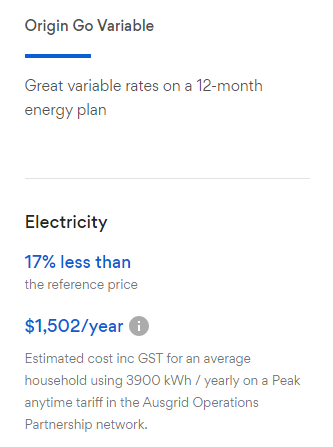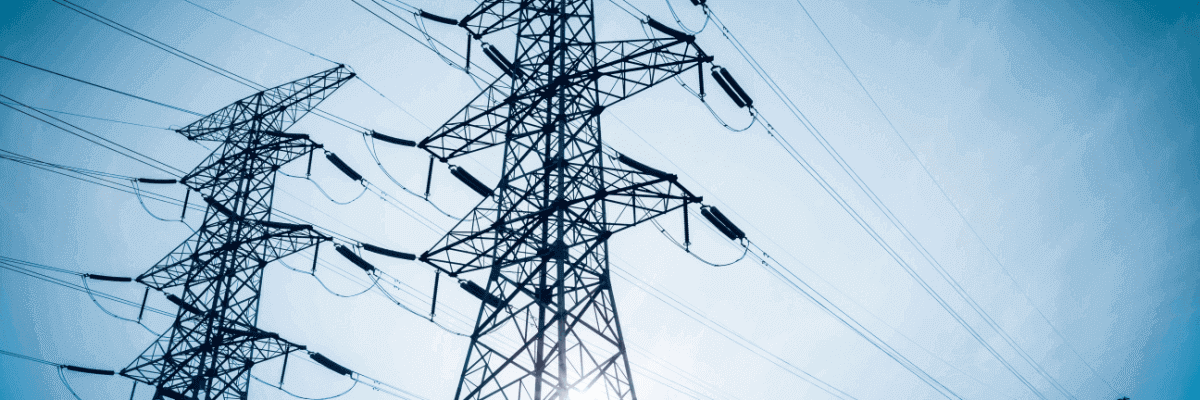KEY POINTS
- The electricity reference price serves as a price cap for energy retailers and a benchmark for consumers to compare energy plans.
- The reference price isn’t the cheapest possible price for energy, but it typically represents the most you can be charged by an energy provider on a non-competitive plan.
- While the reference price is a useful point of comparison, it is important to study your preferred plan’s charges, fees and inclusions.
On this page:
- What is the electricity reference price?
- How do electricity reference prices work?
- Where is the electricity reference price used?
- Is staying on the electricity reference price worth it?
- How do I use the electricity reference price?
- Understanding your electricity plan
- How much is the electricity reference price?
- Compare energy plans
What is the electricity reference price?
The electricity reference price, set by the Australian Energy Regulator (AER) every July, acts as a price cap for energy retailers and a consistent and clear point of reference against which consumers can compare energy plans.
The reference price wasn’t introduced to be the cheapest plan possible, but it typically reflects the highest price a customer can be charged by an energy provider if they don’t shop around – this protects Aussies from the higher prices they paid before its introduction.
How do electricity reference prices work?
The AER sets electricity reference prices by first modeling what a representative customer could pay for energy in each state based on the following:
- Annual energy usage patterns in each state (e.g. 4,000kWh)
- Different usage and supply rates from geographic differences
- Tariff type or how customers are charged for electricity
- Distributor networks operating in each state
Note: Because representative customers are based on a simple set of assumptions, your exact energy usage or distributor network may differ.
Energy providers then use the reference price in the states they do business in as a base to set their standing offers, which are legally required, and market offers:
- Standing offers: A standing offer is the default plan customers are given if they don’t proactively engage in the energy market (e.g. switch or compare energy plans). Standing offers are priced according to the relevant reference prices. You can also request to be on your retailer’s standing offer.
- Market offers: Market offers are energy plans set by retailers with their own usage and supply charges, discounts and conditions. Market offers are typically cheaper than the standing offers to entice customers to sign up. Electricity retailers can still charge more than the electricity reference price through their market offers. However, this is discouraged by government regulators.
Customers are automatically rolled over onto their retailer’s standing offer when their market offer plan expires, typically after 12 months.
Where is the electricity reference price used?
The electricity reference price is used across NSW, SEQ and SA. In these areas, it’s called the Default Market Offer (DMO).
In VIC, customers have a similar electricity reference price, but this is known as the ‘Victorian Default Offer’. It doesn’t act as a price cap in quite the same way as the electricity reference price, but it is similar in that customers on old standing offers are switched onto the cheaper default price.
Is staying on the electricity reference price worth it?
No, we do not recommend staying on the electricity reference price. The electricity reference price is generally the most that you will pay if you don’t sign up for a market offer.
It was designed to help compare plans and ultimately pick the right market offer, ideally a cheaper one with better electricity rates and discounts. It was only competitive for customers who were switched from an old standing offer to the reference price when it was first introduced.
Customers who don’t shop around in the energy market may find that they are already sitting on the electricity reference price by default. This can be verified under the plan information section when reading your previous energy bill.
Consumers who shop around and compare their options still stand to save the most, just like before the DMO was released.
How do I use the electricity reference price?
All energy retailers are legally required to advertise how their market offers compare against the reference price on their websites in NSW, SEQ and SA, discounted or otherwise.
For market offers with discounts, there could be three different prices quoted: the electricity reference price, the price when conditions of a discount are not met and the price when conditions of a discount are met.
This is expressed as a percentage (%) difference.
Example: advertised plan price comparing costs to a reference price

Image: origin.com.au
This empowers customers to make quick and fuss-free comparisons when shopping around for a new energy plan.
Now with a better understanding of reference prices, you can compare different offers to find the best option for your energy needs.
You can start with the table below, which shows a comparison of the cheapest deals on the Canstar Blue database, with the plan’s savings compared to the electricity reference price as a percentage (%) difference.
Here are some of the cheapest published deals from the retailers on our database that include a link to the retailer’s website for further details. These are products from referral partners†. These costs are based on the Ausgrid network in Sydney but prices may vary depending on your circumstances. This comparison assumes general energy usage of 3900kWh/year for a residential customer on a single rate tariff. Please use our comparison tool for a specific comparison in your area and to see other products in our database that may be available. Our database may not cover all deals in your area. As always, check all details of any plan directly with the retailer before making a purchase decision.
Here are some of the cheapest published deals from the retailers on our database that include a link to the retailer’s website for further details. These are products from referral partners†. These costs are based on the Energex network in Brisbane but prices may vary depending on your circumstances. This comparison assumes general energy usage of 4600kWh/year for a residential customer on a single rate tariff. Please use our comparison tool for a specific comparison in your area and to see other products in our database that may be available. Our database may not cover all deals in your area. As always, check all details of any plan directly with the retailer before making a purchase decision.
Here are some of the cheapest published deals from the retailers on our database that include a link to the retailer’s website for further details. These are products from referral partners†. These costs are based on the SA Power network in Adelaide but prices may vary depending on your circumstances. This comparison assumes general energy usage of 4000kWh/year for a residential customer on a single rate tariff. Please use our comparison tool for a specific comparison in your area and to see other products in our database that may be available. Our database may not cover all deals in your area. As always, check all details of any plan directly with the retailer before making a purchase decision.
Understanding your electricity plan
While reference prices and market offer estimates are a useful point of comparison, it doesn’t reveal all that you need to know about any given plan. Let’s break it down.
For starters, market and standing offer prices are estimates based on a specific usage amount. In simple terms, if you consume more electricity than the estimated amount, you’ll end up paying more. If you consume less, you’ll pay less.
If your household doesn’t use much electricity, it’s worthwhile checking your preferred plan supply charges — the daily fixed cost to supply electricity to your home. In this situation, plans with lower supply charges could save you more money.
Conversely, if your home uses a lot of electricity, you’ll have to focus on your preferred plan’s usage rates instead — the cost you pay for every kilowatt-hour (kWh) of electricity you consume. That way, you’re not caught out overpaying.
On top of that, prices shown for a market offer with discounts don’t spell out the conditions you need to meet to qualify, such as paying on time or by direct debit. However, no plan can result in prices higher than the reference price when these conditions aren’t met. Other non-dollar discounts that might appeal to you (e.g. reward point bonuses) aren’t included in the final figure.
All this information can be conveniently found on a plan’s energy fact sheet. Therefore, it pays to research before committing to one given plan.
How much is the electricity reference price?
The following table shows single rate tariff and single rate + controlled load reference prices across the different energy networks in NSW, SEQ and SA, plus the usage assumptions (kWh) used to calculate them.
Electricity reference price in NSW
← Mobile/tablet users, scroll sideways to view full table →
| tate | Energy network | Flat rate annual cost | Flat rate + controlled load annual cost |
|---|---|---|---|
| NSW | Ausgrid | $1,965 (3,900kWh) | $2,717 (6,800kWh) |
| NSW | Endeavour | $2,411 (4,900kWh) | $3,072 (7,400kWh) |
| NSW | Essential | $2,741 (4,600kWh) | $3,211 (6,600kWh) |
Source: AER. Accurate as of August 2025
Electricity reference price in SEQ
| State | Energy network | Flat rate annual cost | Flat rate + controlled load annual cost |
|---|---|---|---|
| SEQ | Energex | $2,143 (4,600kWh) | $2,425 (6,300kWh) |
Source: AER. Accurate as of August 2025
Electricity reference price in SA
| State | Energy network | Flat rate annual cost | Flat rate + controlled load annual cost |
|---|---|---|---|
| SA | SA Power | $2,301 (4,000kWh) | $2,824 (6,000kWh) |
Source: AER. Accurate as of August 2025
Compare energy plans
The electricity reference price can help to put downward pressure on overall energy prices, but remember that price is only one consideration when it comes to finding the best energy plan.
Customer service and other value-adding incentives are other variables to consider when shopping around.
Canstar Blue’s electricity comparison tool includes a unique value rank feature that compares plans that offer the best overall value, not just the cheapest prices. Click on the link below to start comparing plans now.
Frequently asked questions about the electricity reference price
Before the introduction of the reference price, there was no limit to what energy retailers could charge their customers in deregulated (i.e. rates were no longer set by state governments or regulators) areas of the country. This created highly competitive energy markets in these areas, with many new energy retailers forming and competing for business.
But while consumers shopped around, compared prices and found good deals, some didn’t and instead, found themselves on expensive plans known as ‘standing offers’. Standing offers were default contracts that generally came with the highest prices, which led to the term ‘lazy tax’ to describe the fact that customers were effectively punished for not shopping around and switching retailers.
There was no benchmark price from which energy discounts were applied, so the market became extremely confusing for consumers. Some big discount plans worked out to be more expensive than plans with smaller discounts because those discounts weren’t applied to the same base pricing.
Energy retailers could (and did) place a large discount on very high base rates, giving consumers the impression that their plan was going to deliver great savings, when in reality, customers just had a big discount off a big bill. The rise of conditional discounts also resulted in higher prices for those who failed to meet their energy plan’s conditions, such as paying on time.
The Australian Competition and Consumer Commission (ACCC) saw enough evidence of the energy retailers’ price gouging and launched an inquiry into the energy retail market. The ACCC included a series of recommendations on what needed to change to make it easier for consumers to understand and ultimately save them money.
One recommendation was to replace standing offers with a ‘Default Market Offer’ (a plan priced at the reference price). Consumers on a standing offer contract would then be switched automatically onto their retailer’s DMO and pay the electricity reference price for energy instead of the higher standing offer rates.
The exception to this would be if a standing offer was already cheaper than the electricity reference price. In this case, the retailer would be expected to maintain its offer to the consumer. However, it is extremely rare to find such a cheap standing offer in the first place.



Share this article